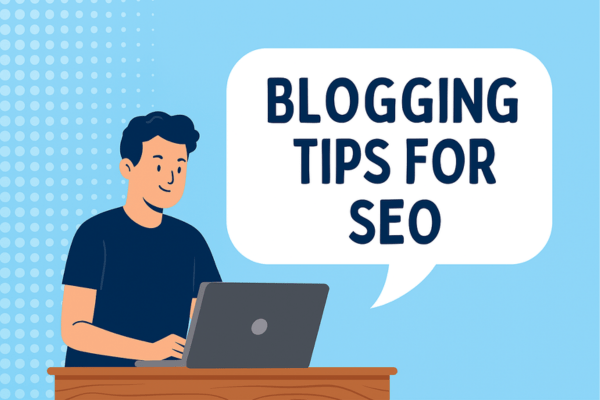Within our broad digital world, a blog has evolved beyond merely sharing your musings to be an incredible engine for organic traffic, authority, and reader-client conversion. If you are a professional, particularly a consultant, small business owner, or expert in your field, then capitalizing on your blog for search engine optimization (SEO) is critical.
This all-encompassing manual is designed to explain the best Blogging Tips for SEO that are custom-made for professionals, whose insights need to be found by the right audience. Prepare to make your blog an online presence that not only records your thoughts but also attracts potential clients by utilizing the tried and true Blogging Tips for SEO.
Why Blogging is Still Essential for Professional SEO
In a world of video and social media, some may wonder if blogging still matters. For professionals, a blog is still a valuable tool for SEO, no matter your profession. A blog is long-form content that search engines love, and it has great potential for targeting keywords and showing your level of expertise. A blog will increase consistent organic traffic over time, authority in your niche, and establish you as a thought leader. It’s smart to take advantage of some Blogging Tips for SEO so your knowledge doesn’t get lost in the digital space.
Keyword Research: The Cornerstone of All Blogging Tips for SEO
You could have created an incredibly insightful blog post, but if no one is searching for your post’s topic, then it wouldn’t attract any traffic at all. Keyword research is basically the first step in any successful set of Blogging Tips for SEO.
- Identify your audience’s questions: What issues are your perfect clients trying to solve? What kind of information are they seeking?
- Get help from Keyword Tools: Programs such as Google Keyword Planner, Ahrefs, SEMrush, or Ubersuggest make it easier for you to discover keywords related to your topic, get an idea of the search volume, and also check the competition.
- Target Long-Tail Keywords: These are longer and more detailed phrases (e.g., “best project management software for small creative teams”). Although they have lower search volumes, conversion intents are higher.
- Study Competitors: Check out the keywords your competitors are ranking for, then find the ones you are not and use them to your advantage.
In short, keyword research is the most important of all Blogging Tips for SEO as it leads your content strategy.

Crafting Compelling & Optimized Titles
The title of your blog post is the first thing that search engines and your potential readers will see, It needs to be keyword-rich and excite someone’s curiosity and interest.
- Include your primary keyword: Get your main keyword close to the front of the title.
- Be descriptive and clear: Describe exactly what the post is about.
- Power Words: Words like “Ultimate,” “Complete,” “Essential,” “Guide,” “Secret,” “Proven,” or “Mastering” can help increase click-through rates.
- Considering numbered lists, like “5 Ways to…” and “10 Blogging Tips for SEO,” which generally work really well.
- Keep it short: 50 – 60 characters should suffice for ideal display in search results.
A well-optimized title is an important component of successful Blogging Tips for SEO.
Structure for Success: Headings, Paragraphs, and Readability
Once, even the finest content fails to be effective if it’s presented in the form of a giant wall of text. Search engines give priority to user experience, and a well-organized blog post is easier to understand for both humans and bots.
Headings (H1, H2, H3) are a Great Tool: Use not just headings, but also descriptive and to-the-point ones to separate your content. The main title is H1, while the following subheadings should be H2, H3, etc. Simply by being a natural part of your subheadings, the keywords will get there too.
- Write Short Paragraphs: The goal should be 2-4 sentences per paragraph. This length is great for readability, especially on mobiles.
- Bullet Points & Numbered Lists: They visually separate text, make it easier to highlight the key points of the content, and allow the readers to go through the content quickly.
- White Space: Don’t worry about the space left on the page. It makes the content less frightening.
Good writing is the base of the most effective Blogging Tips for SEO because it keeps the audience happy and makes it easier for search engine crawlers to navigate.
Content Quality & Depth: Beyond the Basics
The algorithms used by Google are getting more sophisticated, rewarding high-quality, in-depth content which fits the user’s intent (thinner, lower-content articles won’t cut it).
- Be comprehensive: Try to provide the most complete answer to the user’s inquiry.
- Be unique: You, as a professional, are unique. Tell them what you believe – don’t just relay others’ words!
- Be authoritative: Support your findings with data, real-life examples, or quotes from experts in the field.
- Longer Posts: The longer the post (800-1500+ words), the better it performs. Longer posts are often more thorough and get more backlinks.
- Consider the user intention: Think about the reason someone searched for that keyword (answer that question in your blog).
High-quality, in-depth content might be the single most powerful of all of the Blogging Tips for SEO.
Optimize Your Images: A Visual SEO Boost
Images can add value to your blog far beyond aesthetics. If you do not optimize images, you are losing out on potential traffic.
- Descriptive File Names: Use a descriptive file name for your image or infographic file, using words that reflect what is in the image (Example: “blogging-tips-seo-infographic.jpg” vs. “IMG_1234.jpg”)
- Alt Text: Use descriptive alt text to identify what the image shows, for the visually impaired, and to help search engines figure out what an image is about. Use keywords where it is natural.
- Compress Images: Use a tool like TinyPNG or Imagify to compress the file size of an image. You do not need to sacrifice quality to compress file size, and a larger image will slow your page load speed – this is a negative SEO factor.
- Relevant Images: Use relevant images that relate to the content of the article.
Image optimization is an important but overlooked aspect of Blogging Tips for SEO.
Internal & External Linking Strategies
Improving the user experience and your SEO are both benefits of strategic linking.
- Internal Links: Link to other posts on your own blog/website that are relevant. This will help the reader navigate your content, keep them on your site longer, and spread “link juice” (authority) to your page.
- External Links: When you cite statistics, research, or experts, link out to something highly authoritative and reputable. This helps your audience see you’re adding credibility and shows Google you’re creating credible, researched content; you can’t just claim something a statistic without referencing it.
- Anchor Text: Use descriptive, rich-in-keywords anchor text when linking (i.e., “learn more about these Blogging Tips for SEO” instead of the generic “click here”).
Thoughtful linking is a strong part of Blogging Tips for SEO in establishing relevance and authority.
The Power of User Experience (UX) in SEO
Google is putting more weight on user experience as a ranking factor. If users enjoy an easy and useful experience on your site, they will likely spend more time on your site and have a lower bounce rate. That sends a message to Google that your content is valuable and useful.
- Mobile Responsiveness: Make sure your blog is completely responsive and looks good on all devices.
- Page Load Speed: Optimize your images, use browser caching if available, and consider any hosting provider that will allow your blog to load quickly.
- Clear Call-to-Actions (CTAs): Let the user know what they should do next (e.g., download our free E-book, schedule a consultation).
- Easy Navigation: Make it easy for users to find relevant content on your blog.
A good user experience is a powerful but indirect driver of your Blogging Tips for SEO success.
Promote Your Blog: Expanding Your Reach
First and foremost, writing amazing content is only half the way; you still need to promote it actively to extend its reach and garner backlinks.
- Social Media: Share your blog posts on all the social media channels that are relevant to you.
- Email Newsletter: Tell your subscribers about new posts.
- Outreach: Contact industry influencers or websites that may be interested in your content to link to or share it.
- Online Communities: Share your knowledge in relevant forums or groups (without spamming) and link back to your blog if it is appropriate and helpful.
If you use promotional strategies wisely, you will leverage your efforts, making your Blogging Tips for SEO genuinely effective.
Regular Audits & Updates: Keeping Your SEO Fresh
Search engine optimization is not merely a task, but an ongoing process. You need to regularly audit and update your content for it to be effective long-term.
- Monitor your content and performance: Use Google Analytics and Google Search Console to track which posts are performing well, and look for opportunities for improvement overall and through search and performance.
- Update old posts: Update statistics that are outdated, and add new information when you can. Improving the quality and readability of the content can improve performance, and updating do-follow internal links can give old posts a significant boost.
- Fix broken links: Keep a watchful eye on broken internal and external links on your blog, and make sure you are fixing them as needed.
- Remove duplicate content: Check that you do not have two pages competing for the same keywords.
Continuously keeping up with maintenance will help with search engine optimization efforts and continue to deliver results with your blogging tips over time. enuinely effective.
Conclusion
A strong blog is more than just a writing platform—it’s a critical tool for your professional growth. By implementing these Blogging Tips for SEO, you transform your content from static text into a powerful magnet for your target audience. Remember that SEO is a marathon, not a sprint, and your consistent efforts will compound over time. Focus on creating valuable, well-optimized content, and you will build a sustainable source of traffic, establish your authority, and ultimately grow your professional presence.
Frequently Asked Questions (FAQs)
Q. Should I use one keyword per blog post?
Ans: Yes, each blog post should have one primary keyword or topic that it is centered around. However, you should also include related long-tail keywords and synonyms naturally throughout the content. This is a core part of effective Blogging Tips for SEO.
Q. How long should my blog posts be for SEO?
Ans: There’s no magic number, but longer posts (typically over 1,000 words) tend to rank better because they are often more comprehensive and provide more value to the reader. Focus on providing the most complete answer to a user’s query, and the length will naturally follow.
Q. Is it okay to use AI to write my blog posts?
Ans: AI can be a great tool for brainstorming ideas, creating outlines, or drafting initial paragraphs, but it should not replace human writing. Google’s algorithms favor content that is helpful, unique, and demonstrates expertise. Use AI to assist, but always add your own professional insights and personality to make the content valuable and authentic.
Q. How long does it take to see results from my SEO efforts?
Ans: SEO is a long-term strategy, not a quick fix. You may start seeing some initial ranking improvements in a few months, but it can take 6 to 12 months or even longer to see significant organic traffic and meaningful results. The key is to be consistent with your Blogging Tips for SEO efforts.
Q. How often should I update my old blog posts?
Ans: It’s a great practice to audit and update your old content at least once a year. Look for outdated statistics, broken links, or opportunities to add new information. Refreshing old posts is one of the most effective Blogging Tips for SEO because it signals to search engines that your content is current and relevant.

